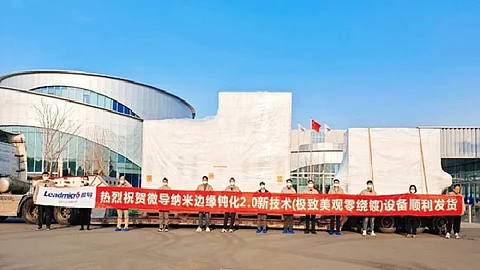

Solar equipment maker Leadmicro has announced that it has shipped its new independently-developed Edge Passivation 2.0 equipment for validation at a customer site. Aimed at the half-cut solar cell application, this equipment boasts an aesthetic finish with zero wrap coating. According to Leadmicro, the equipment features a unique gas flow design that ensures no waste of specialty gas, along with an innovative characterization design that enables single-line monitoring. It adds that the system not only ensures effective passivation of the cut edge but also completely overcomes the wrap coating bottleneck, resolving issues related to cell appearance, false solder joints, and passivation commonly encountered in TOPCon. The company also noted that this technology can also be used in other high-efficiency cell technologies such as XBC and HJT.
LEAD Group, Leadmicro’s parent company, recently decided to terminate its overseas GDR issuance plan on the SIX Swiss Exchange (see China Solar PV News Snippets).
As part of its quarterly index adjustments for February 2025, MSCI has added Canadian Solar (A-share stock code: 688472) to the MSCI China Flagship Index. This includes both the MSCI China Index and the MSCI China A-Shares Onshore Index, and all adjustments will take effect after the close on February 28.
Canadian Solar stated that its inclusion in the MSCI China Flagship Index comes as a result of its leading position in the photovoltaic and energy storage sectors. In the first 3 quarters of 2024, the company achieved operating revenues of RMB 341.8 billion ($46.78 billion) and a net profit attributable to the parent company of RMB 19.5 billion ($2.67 billion). Moreover, as of November 30, 2024, its order backlog for energy storage systems was about 60 GWh, with signed contracts amounting to roughly RMB 230 billion ($31.51 billion).
Solar PV inverter supplier Sineng Electric has announced plans to issue shares to targeted investors, aiming to raise RMB 1.65 billion ($225.3 million) to fund 2 manufacturing plants in Wuxi, Jiangsu Province, apart from supplementary working capital.
The first is an industrialization initiative for a 25 GW annual production capacity string solar PV inverter project, with a total investment of RMB 1,295.93 million ($177.5 million). It plans to use RMB 890 million ($121.9 million) of the raised funds to add an annual production capacity of 15 GW for distributed inverters and 10 GW for large string inverters.
The second project is an industrialization initiative for a 15 GW annual production capacity energy storage converter project, with a total investment of RMB 894.98 million ($122.6 million) and will use RMB 610 million ($83.6 million) in raised funds to establish an automated, intelligent, and large-scale production base for energy storage converter products.
CECEP Solar has started official operations of its self-developed solar module recycling demonstration line. Located in Jianli City, Jingzhou, Hubei Province, the project utilizes a mobile container design that can be rapidly deployed to various sites, enabling on-site recycling of components such as glass, aluminum frames, and junction boxes from decommissioned solar modules – thereby significantly reducing transportation costs. This is said to be China’s first such module recycling demonstration line in the 10,000-ton class.
According to CECEP Solar, the recycling line achieves a disassembly efficiency of up to 60 modules per hour, and the recovered aluminum frames and glass have a purity exceeding 99%.
Perovskite manufacturer Microquanta has announced the completion of what it claims to be the world’s largest dome perovskite project. Installed on the translucent roof of the University Student Entrepreneurship Center in Shenchi County, Shanxi Province, the project has an installed capacity of 17.92 kWp, leveraging building-integrated photovoltaics (BIPV) technology. Microquanta claims that the project simultaneously meets the building’s energy and daylighting needs through the integration of light-transmitting perovskite modules with a dome architectural form. Once fully operational, it is expected to generate an average annual electricity output of 25,300 kWh, with a projected cumulative output of 631,70 kWh over 25 years.
Recently, Microquanta’s 810 cm² medium-sized perovskite module achieved a certified full-area power conversion efficiency of 21.86% (see China Solar PV News Snippets).
